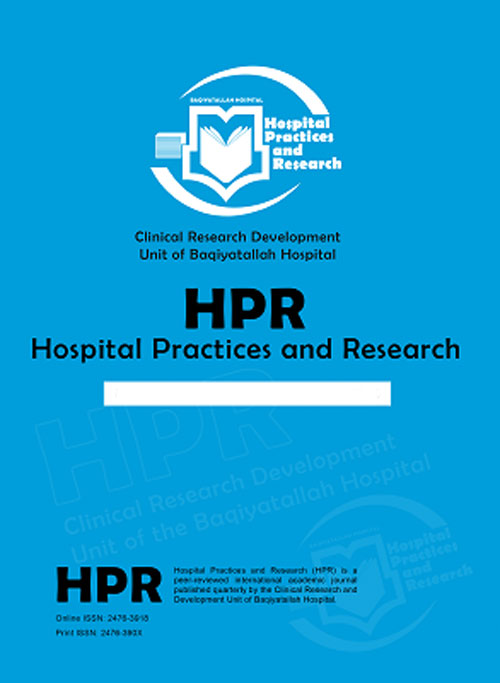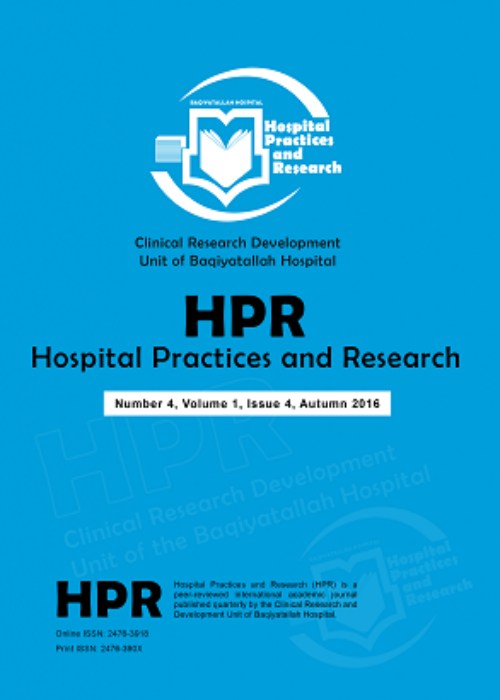فهرست مطالب

Hospital Practices and Research
Volume:4 Issue: 4, Autumn 2019
- تاریخ انتشار: 1398/08/14
- تعداد عناوین: 7
-
-
Pages 111-116Background
Quality of life (QOL) is a powerful phrase that reflects maintaining health and well-being in different societies and cultures, reflecting the positive and negative aspects of people’s lives. Patients with liver cirrhosis (LC) have an undesirable QOL, and this has become one of the most important causes of mortality in the world.
ObjectiveThis review article aimed to summarize the results of previous studies on health-related QOL in patients with LC to determine their problems and needs.
MethodsThis review was conducted using Cochran’s seven-step model. This paper is the result of research on QOL in patients with LC through searches conducted in Google Scholar, PubMed, and Science Direct using the keywords liver cirrhosis, chronic liver disease, quality of life, health-related quality of life, and self-care for articles published between 2012-2018. Ultimately, 11 articles were obtained and analyzed.
ResultsThe results of this review showed that the QOL in patients with LC is poor and is lower than in other populations. Many factors, such as age, gender, and education, influence QOL and should be addressed in order to solve the challenges and problems faced by these patients. Increasing awareness and education are the most important issues for LC patients.
ConclusionQOL in patients with LC is affected by many factors. The lack of awareness about the disease and its complications is considered the biggest problem for these patients. To improve the QOL and care of these patients, nursing care guidelines, awareness raising, and education about the disease and its complications, treatment, and new treatments are needed.
Keywords: cirrhosis, Quality of Life, Self-Care, chronic liver disease -
Pages 117-121BackgroundSeptic shock (SS) is a health priority in sub-Saharan Africa. However, there is a dearth of data in this regard.ObjectiveThis study aimed to determine the epidemiology, therapeutic patterns, outcome, and challenges in managing SS in a tertiary intensive care unit (ICU) of sub-Saharan Africa.MethodsThe hospital files of 36 consecutive patients admitted to the ICU of the Douala General Hospital (DGH), Cameroon over the year 2018 were reviewed for SS. SS was diagnosed based on Sepsis-3 definition. Demographic and clinical characteristics, treatment details, and outcomes of patients with SS were reviewed. Data was analyzed using the chi-square or Fisher exact tests and Bonferroni correction.ResultsSS accounted for 36 (9.4%) ICU admissions. The majority of patients were males (63.9%). The most common site of infection was the lungs. The mean age, average mean arterial pressure (MAP), and mean sequential organ failure assessment (SOFA) score of patients were 52.9±25.2 years, 52±18 mm Hg, and 9.2 ±2.3, respectively. Noradrenaline was the sole vasopressor used. Therapeutic challenges included the inability to have a specific antibiogram before a mean duration of 7 days. The mortality rate was 39% and associated with age ≤1 year, MAP ≤ 65 mm Hg, Glasgow Coma Score (GCS) ≤8, and mechanical ventilation, which were not attenuated after Bonferroni correction.ConclusionSS is a frequent cause of ICU admission and is associated with a high mortality rate. SS mortality-related factors can be screened during SS management for more aggressive ICU management geared at preventing death.Keywords: Septic, Shock, Epidemiology, intensive care, Sub-Saharan Africa
-
Pages 122-127BackgroundThe Minorities’ Diminished Returns (MDRs) theory suggests that the health effect of educational attainment is considerably smaller for members of racial and ethnic minority groups than for Whites.ObjectiveThe current study explored the racial and ethnic differences in the association between educational attainment and Breast Physical Exam (BPE) among women in the U.S.MethodsThe National Health Interview Survey (NHIS 2015) included 12 510 women who were Hispanic or non-Hispanic Black or White people. The independent variable was the level of educational attainment. The dependent variable was lifetime BPE. Age, region, marital status, and employment were the covariates. Race and ethnicity were the focal moderators. Logistic regressions were used for data analysis.ResultsOverall, higher educational attainment was associated with higher odds of BPE, net of all confounders (odds ratio [OR]=1.11, 95% CI=1.09-1.13). Ethnicity showed a significant statistical interaction with educational attainment on BPE (OR=0.96, 95% CI=0.93-1.00), which was suggestive of a smaller effect of high education attainment on BPE for Hispanic than non-Hispanic women. The same interaction could not be found for the comparison of White and Black women (OR = 0.98, 95% CI =0.94-1.02).ConclusionIn line with other domains, non-Hispanic White women show a larger amount of health gain from their educational attainment than Hispanic women. It is not ethnicity or class but ethnicity and class that shapes how people engage in pro-health behaviors. This result may help hospitals and healthcare systems to better reduce health disparities in their target populations.Keywords: Population Groups, Socioeconomic status, Education, Breast, Screening
-
Pages 128-133BackgroundOvercrowding is an important problem for outpatient services in healthcare facilities. Patient flow analysis (PFA) is a useful method for identifying inefficiencies in and facilitating patient flow.ObjectivePFA was used to estimate patient wait time and determine how different clinical disciplines impact wait times in the studied hospital.MethodsThis cross-sectional study investigated a study population comprised of outpatients who referred to clinics at a general hospital in Tehran, Iran. A total of 3836 samples were selected from different stations. Nonrandomized quota sampling was used, and data was gathered using workflow checklists, the content validity of which was proven by experts and hospital authorities. SPSS statistical software was used for data analysis.ResultsTotal patient stay in the outpatient setting was an estimated 77 minutes (without considering para-clinic units and pharmacy). More than 90% of this time was spent waiting. The wait time of patients at the clinic was greater than that at other stations, and it was less at the cash station than at other stations. Wait times varied at different clinics (P value < 0.001) and were correlated with physician delay (P value < 0.001).ConclusionThe most important result of using PFA in the outpatient setting was managing wait times. This study indicated that a considerable amount of a patient’s total stay in the system was related to waiting for physical examinations. This suggests that the first priority in improving the system should be managing patient wait times for physical examinations.Keywords: Outpatient Clinics, Hospital, Health Services Accessibility, Time, Motion Studies
-
Pages 134-138BackgroundFor decades, static stretching has been the standard benchmark for training programs, because it has been shown to increase flexibility compared with other methods of stretching.ObjectiveThe current study investigated and compared the effects of active dynamic stretching and passive static stretching on hamstring tightness.MethodsFor this experiment, 64 female students were enrolled and randomly assigned to active dynamic or passive static stretching groups (n = 32 each). The first and second experimental groups were trained with repetitive dynamic stretching and static stretching exercises, respectively. Exercises were performed 10 times per limb, 3 times per day, 5 days per week for 4 weeks. Hamstring muscle length measurements were repeated in weeks 2 and 4. Statistical analysis of the results was performed by t-test and repeated measures ANOVA using SPSS 15.ResultsBoth experimental groups showed significant improvements in the active knee extension range of motion during the intervention (P < 0.001). However, active stretching showed better results and had a greater effect on range of motion in comparison with static stretching.ConclusionActive dynamic training can be considered a suitable method for increasing the flexibility of the hamstring muscle and, consequently, reducing the complications and problems associated with hamstring tightness.Keywords: Training, Exercise, therapeutic, treatment
-
Pages 139-141Introduction
Suicide is a major challenge to public health worldwide, and self-inflicted burn is one of the most violent suicide methods.
Case PresentationIn this case, a self-inflicted hot oil burn in a male with schizotypal personality and major depressive disorder is reported.
ConclusionPsychiatric disorders, marital problems, and economic poverty are mentioned as risk factors for self-inflicted burn. Thus, these risk factors should be considered in the management of self-inflicted burn patients.
Keywords: Suicide, Burn, schizotypal personality disorder, Forensic medicine, Depressive disorder, self-Injurious behavior -
Pages 142-143


